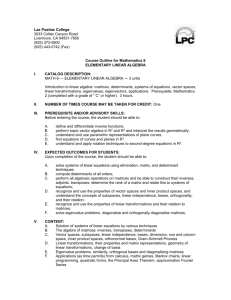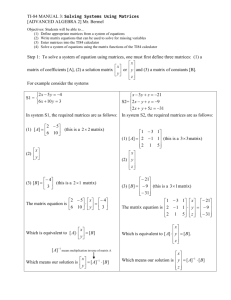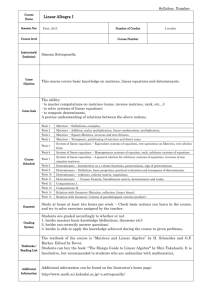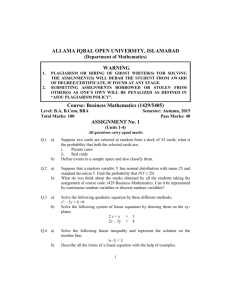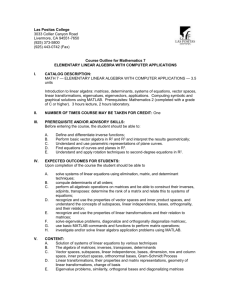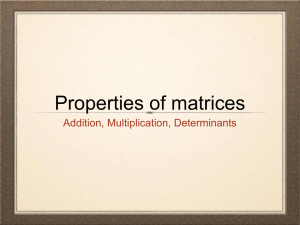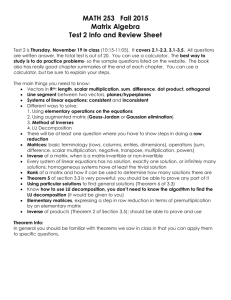SMS 1205 Linear Algebra (New) - International Islamic University
advertisement
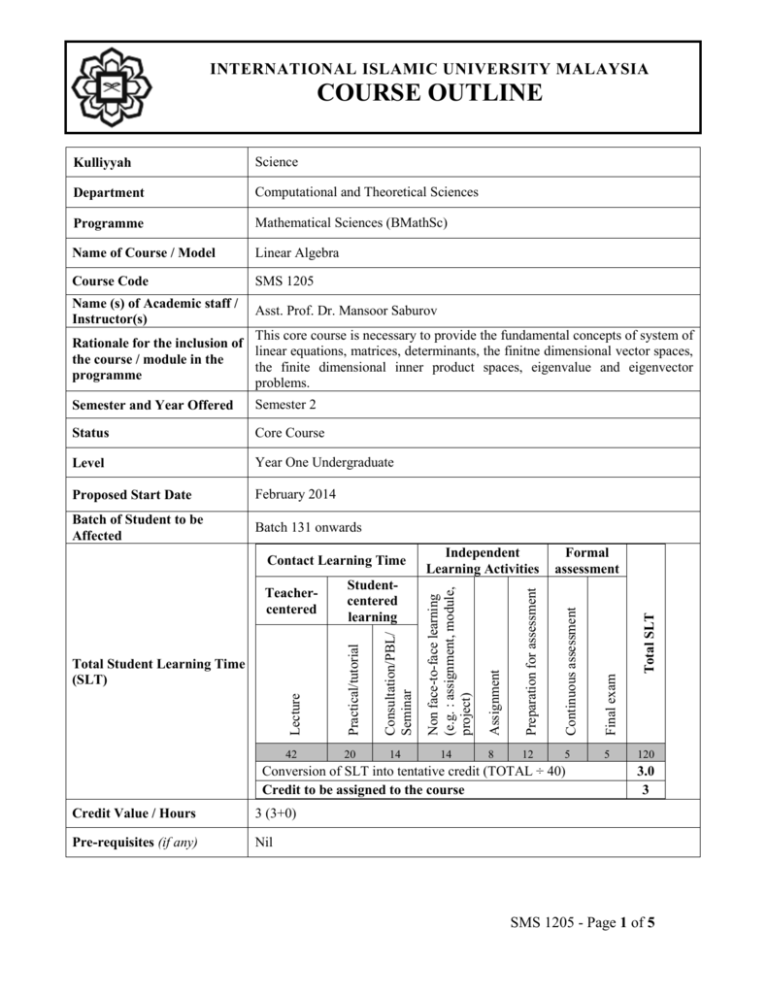
INTERNATIONAL ISLAMIC UNIVERSITY MALAYSIA COURSE OUTLINE Kulliyyah Science Department Computational and Theoretical Sciences Programme Mathematical Sciences (BMathSc) Name of Course / Model Linear Algebra Course Code SMS 1205 Name (s) of Academic staff / Instructor(s) Asst. Prof. Dr. Mansoor Saburov This core course is necessary to provide the fundamental concepts of system of Rationale for the inclusion of linear equations, matrices, determinants, the finitne dimensional vector spaces, the course / module in the the finite dimensional inner product spaces, eigenvalue and eigenvector programme problems. Proposed Start Date February 2014 Batch of Student to be Affected Batch 131 onwards Contact Learning Time 42 20 Consultation/PBL/ Seminar Lecture Total Student Learning Time (SLT) Studentcentered learning Practical/tutorial Teachercentered 14 Independent Learning Activities 14 8 Formal assessment 12 5 5 Conversion of SLT into tentative credit (TOTAL ÷ 40) Credit to be assigned to the course Credit Value / Hours 3 (3+0) Pre-requisites (if any) Nil Total SLT Year One Undergraduate Final exam Level Continuous assessment Core Course Preparation for assessment Status Assignment Semester 2 Non face-to-face learning (e.g. : assignment, module, project) Semester and Year Offered 120 3.0 3 SMS 1205 - Page 1 of 5 Co-requisites (if any) Nil Course Objectives The objectives of the course are to: 1. Provide a foundation of the theory of matrices, determinants, and solving of system of equations;. 2. Provide an axiomatic theory of the finite dimensional vector spaces, inner product spaces, and linear operators acting on them; 3. Expose the spectral theory of matrices (linear operators) 4. Provide an language and a powerful framework for posing and solving important applied problems encountered in various fields of mathematical science. Upon completion of this course, students should be able to: Learning Outcomes 1. Identify systems of linear equations, matrices, vector spaces, linear transformations and Solve systems of linear equations (PO1, PO3, PO4, PO5, PO7, PO9, CTPS3, C1, CS3, C3, P3, A3) 2. Understand properties of matrices and determinants. (PO1, PO3, PO4, PO5, PO7, PO9, CTPS3, LL2, C3, P3, A3) 3. Formulate axioms and prove theorems on vector spaces. (PO1, PO3, PO4, PO5, PO7, PO9, CTPS3, LL3, C3, P3, A3) 4. Inner product Space and Orthogonal Basis (PO1, PO3, PO4, PO5, PO7, PO9, CTPS3, LL3, C3, P3, A3) 5. Apply linear transformations, eigenvalues and eigenvectors. (PO1, PO3, PO4, PO5, PO7, PO9, CTPS3, CS3, LL2, C3, P3, A3) Transferable Skills: Assignment Tutorial √ Communication Critical Thinking / Problem solving Creativity / Inovation ICT / Information Management Teamwork Teaching-Learning and assessment strategy Quiz Exam Skill No. 1 2 3 Presentation Skills and how they are developed and assessed, project and practical experience and internship Assessment How skills are developed √ √ Teaching-Learning Lecture Tutorial Practical /Presentation √ √ √ √ √ √ √ √ Oral presentation, Group Discussion, Short answer Group discussion, Tutorials Oral presentation, Tutorials Collecting data and information for report Group presentation, Laboratory Assessment Quiz, Assignment, Exam Quiz, Q & A Write-up / Report SMS 1205 - Page 2 of 5 Course Synopsis Systems of linear equations. Matrices. Determinants. Vector spaces. Rank and dimension. Inner product space. Linear transformations. Orthogonality. Eigenvalues. Diagonalisation of real symmetric matrices. Applications. Mode of Delivery Lecture, Tutorial, Practical/Presentation, Quizzes, Assignments LO Assessment Methods and 1, 2, 3, 4,5 Type / Course Assessment State weightage of each type of 1, 2, 3, 4, 5 assessment. 1,2,3 3,4,5 Method % 20 10 30 40 100 Assignments Quizzes Mid-term test Final examination Total Mapping of course / module to the Programme Learning Outcomes √ √ √ √ √ √ √ √ √ √ √ √ √ √ √ √ √ √ √ √ 4. Inner product Space and Orthogonal Basis. √ √ √ √ √ √ √ 5. Apply linear transformations, eigenvalues and eigenvectors. √ √ √ √ √ √ √ √ PO 10 PO 7 √ 3. Formulate axioms and prove theorems on vector spaces. PO 9 PO 6 PO 8 PO 5 linear transformations and Solve systems of linear equations. 2. Understand properties of matrices and determinants. PO 4 1. Identify systems of linear equations, matrices, vector spaces, PO 3 PO 1 Learning Outcome of the course PO 2 Programme Outcomes √ Content outline of the course / module and the SLT per topic 1 2 System of linear equations Introduction to Systems of Linear Equations, System of linear equations, Gaussian Elimination Matrices: Operation with Matrices and Properties. The Inverse of the matrices, Elementary Matrices 3 3 1 1 2 2 1 1 1 1 Review for test/quiz Assessment (quizzes/mid sem/final Assignment Self Study Practical/ Others Tutorial Topics Lecture Weeks Learning Hours 0 0 0 0 Task/Reading Chapter 1 Lay D.C. or Larson&Falvo Chapter 2 Lay D.C. or Larson&Falvo SMS 1205 - Page 3 of 5 3 4 5 6 7-8 9 10 11 12-13 14 Determinants: Determinants and Properties of Determinant. Evaluating the Inverse of the Matrices, Solving System of Equation Vector spaces: Definition of Vector Space, Subspace, Examples Linear dependence and independence Spanning sets, Linear dependence and independence, Basis and Dimension Rank of Matrices Rank of Matrices, System of Equations, Kronecker –Capelli theorem Inner product spaces Inner product space, Angle between vectors, Cauchy-Schwarz inequality, Pythagorean theorem Gram-Schmidt Process Orthonormal basis, Gram-Schmidt Process Linear Transformations: Linear transformations, null space and range, the relation between null space and range Matrix of Linear Transformation Matrix of Linear Transformation, Matrix of changing bases, Similarity Eigenvalues and eigenvectors Eigenvalues and eigenvectors, Characteristic Equation, Diagonalization Symmetric Matrices Symmetric Matrix, Orthogonal Matrix, Orthogonal Diagonalization TOTAL Chapter 3 Lay D.C. or Larson&Falvo 3 3 1 1 1 1 1 1 0 0 1 1 1 1 Chapter 4 Lay D.C. or Larson&Falvo Chapter 4 Lay D.C. or Larson&Falvo 3 3 1 1 2 2 1 1 1 1 0 0 0 0 6 2 2 2 0 2 2 3 1 2 1 1 0 0 3 1 2 1 1 0 0 Chapter 4 Lay D.C. or Larson&Falvo Chapter 6 Lay D.C. or Chapter 5 Larson&Falvo Chapter 6 Lay D.C. or Chapter 5 Larson&Falvo Chapter 6 Larson&Falvo Chapter 6 Larson&Falvo 3 6 1 2 1 2 1 2 0 0 1 2 1 2 3 1 1 1 0 1 1 42 14 20 14 6 8 8 Required Learning Duration Chapter 5 Lay D.C. or Chapter 7 Larson&Falvo Chapter 7 Lay D.C. or Larson&Falvo 112 Main references supporting the course Required Lay D.C. (2012). Linear Algebra and Its Applications (2nd Ed.), Addison Wesley Larson R. & Falvo D. (2009) Elementary Linear Algebra (6th Ed.), Houghton Mifflin Harcourt. Springer-Verlag Berlin Heidelberg. SMS 1205 - Page 4 of 5 Additional references supporting the course Recommended Thomas S. Shores (2007) Applied Linear Algebra and Matrix Analysis (6th Ed.) Springer. Johnson L.W., Riess R.D. & Arnold J.T. (1997). Introduction to Linear Algebra (4th Ed.), AddisonWesley. Prepared by: Checked by: Approved by: Dr. Mansoor Saburov Lecturer, CTS Kulliyyah of Science Dr. Pah Chin Hee Head of CTS Kulliyyah of Science Prof. Dr. Kamaruzzaman Yunus Dean Kulliyyah of Science SMS 1205 - Page 5 of 5

